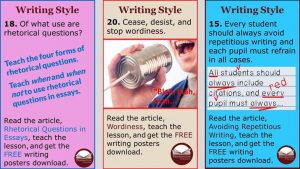Essay Writing Style

24 Free Writing Style Posters
Essays do share some common writing rules, conventions, or guidelines. Among these are elements of writing style. Different than grammar, usage, or mechanics rules, these elements of writing style help student writers avoid the pitfalls and excesses of formulaic, padded, and contrived writing.
Additionally, using these elements of writing style helps students improve coherence and readability.
Although writing style can and will become personalized for sophisticated writers, English-language arts teachers play a significant role in developing that style. I’ve developed a set of FREE 24 Essay Writing Style Posters to teach and reference what not to write in informational/explanatory and argumentative essays.
Written with tongue firmly planted in cheek, teachers and some students will appreciate the humorous advice. Each of the following links to a short teaching article on the writing style subject. The FREE Writing Style Posters download button follows my relevant program descriptions.
Essay Writing Style Rules
-
- Avoid intentional fragments. Right?
- Avoid using big words when more utilitarian words would suffice.
- I have shown that you should delete references to your own writing.
- Generally be sort of specific in your writing.
- Avoid using very interesting, nice words that contribute little to a sentence.
- Prepositions are not good to end sentences with.
- It is a mistake to ever split an infinitive.
- Avoid similes like the plague.
- But do not start a sentence with a coordinating conjunction.
- Always, avoid attention-getting alliteration.
- In my opinion, using “I think” or “I believe” is unnecessary.
- Writers should always avoid using generalizations.
- In this day and age, using clichés is not a necessary evil.
- Parenthetical remarks should (usually) be avoided.
- Always avoid repetitious verbs and avoid repetitious verb phrases always.
- Even if a metaphor hits a home run, it can be over-played.
- The passive voice is a form to be avoided, if it can be helped.
- Of what use are rhetorical questions?
- Avoid exaggeration; it only works once in a million years.
- Cease, desist, and stop wordiness.
- There are good reasons to avoid starting every sentence with There.
- It goes without saying to avoid using formulaic phrases.
- Never write no double negatives
- Keep pronoun references close to subjects in long sentences to make them clear.
*****

Pennington Publishing Writing Programs Integrated Writing and Grammar.
If you’re searching for the right grammar program, I provide three different year-long, one-hour per week programs to teach grammar, usage, and mechanics–each with a different approach.
- Teaching Grammar, Usage, and Mechanics Traditional program grades 4, 5, 6, 7, and 8 and high school with notetaking, mentor texts, simple sentence diagrams, dictations, and connected writing practice–all with a fun secret agent theme. Interactive Google slides or print (PDF)
- Syntax in Reading and Writing Functional, sentence-level syntax, indebted to William Van Cleave and Virginia Tufte. Kernel sentences, sentence expansion and combination, writing analysis and revision. Designed to improve reading comprehension and writing sophistication. Print (PDF) grades/levels 4-12. Each lesson leveled easy, medium, and challenging.
- Grammar, Usage, and Mechanics Notebook A no-mess, 3d foldables, labeling and coloring project approach, featuring grammar cartoons and plenty of writing practice. Print (PDF) grades/levels 4-8.
Each grade-level grammar, usage, and mechanics program provides systematic, explicit, and rigorous instructional resources–no bell ringers, daily error fix-a-thons, or daily oral language. Two 25-minute lessons per week, consisting of scripted notetaking, mentor texts, simple sentence diagrams, dictations, and connected writing practice. Plus, each program includes my grammar and mechanics diagnostics with corresponding worksheets for remedial practice.
If you’re searching for a comprehensive essay program, TEACHING ESSAYS BUNDLE includes the three printable and digital resources students need to master the CCSS W.1 argumentative and W.2 informational/explanatory essays. Each no-prep resource allows students to work at their own paces via mastery learning. How to Teach Essays includes 42 skill-based essay strategy worksheets (PDFs and 62 Google slides), beginning with simple 3-word paragraphs and proceeding step-by-step to complex multi-paragraph essays. One skill builds upon another. The Essay Skills Worksheets include 97 worksheets (printables and 97 Google slides) to help teachers differentiate writing instruction with both remedial and advanced writing skills. The Eight Writing Process Essays (printables and 170 Google slides) each feature an on-demand diagnostic essay assessment, writing prompt with connected reading, brainstorming, graphic organizer, response, revision, and editing activities. Plus, each essay includes a detailed analytical (not holistic) rubric for assessment-based learning.